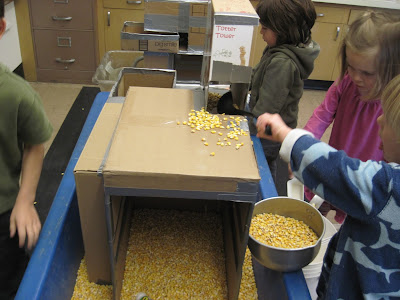Here is a very simple example of what I am talking about. The example features a couple of play episodes around an apparatus I built back in 2012. I called it a box metropolis. I built the construction over three weeks, adding boxes each week until there were a total of 25 boxes all connected in and around two sensory tables.
In the first play episode, a child scooped corn from inside one of the boxes. To do that, he had to bend down and lean under and into the box. There is plenty of corn in the open portion of the table, so why did he feel compelled to gather corn from inside that box?
By the way, by having to bend over and reach under and into the box, the child is strengthening his core and working on his balance. His feet were slightly spread for balance and his right hand grabbed the lip of the table for even more stability. He was probably working a lot of other muscle groups, too, simply by bending, reaching and scooping and then reversing the process to fill his metal pot.
He used a plastic yellow scoop to collect the corn in his metal pot. He did that hands-free because he balanced the pot on the lip of the table. He was able to do that because he also leaned the pot up against the box. The metal pot would have been less stable without the help of the box.
How did he figure that out? Was it just trial-and-error? What's interesting was that he balanced the pot using the edge of the box so only a tiny portion of the pot reached in beyond the edge. That also allowed him easy access for pouring the corn into the metal pot.
At this point, he exchanged his yellow scoop for a black plastic ladle. He then filled his ladle with corn from the metal pot.
Why did he switch utensils? Not only did he switch utensils, but he also moved the pan slightly to the right on the lip of the table. He still used his left hand for scooping. Was that because he was left handed or was it because it made more sense to use his left hand since the pot was on his right side?
He then used the ladle to put some corn into the narrow opening of another, higher box. For all practical purposes, the only way he could do that was with his left hand.
That was not such an easy operation because to get the corn in that hole, he had to lift the ladle up to the height of his shoulder, cross his midline, insert the ladle in the hole and twist his wrist to empty the ladle.
The second episode was quite similar. A child on the other side of that same narrow box placed a plastic green cup just inside the box. He put corn into the cup with a long handled spoon, again lifting it from the table to the height of his shoulder. He used his left hand to scoop, but then enlisted the help of his right hand to guide the spoon into the box. Twisting his wrists, he emptied the spoon. Because that was such a narrow opening, some of the corn went into the cup and some not.
Making coffee from Thomas Bedard on Vimeo.
He said that the box was a machine for making coffee. Was he recreating an experience he had watching an adult make coffee? Did the corn kernels and the sound of them remind him of coffee beans?
From these two short episodes, I would have to conclude that the apparatus changed/enhanced play and exploration at the sensory table. Imagine the table without the apparatus. That particular play never would have happened. Sure, other play would have happened, but the play potential with the apparatus in the sensory table increases significantly. Because there was not one way to play with and explore the apparatus, the children created their own challenges like pouring corn into a hole at shoulder level. In addition, the fact that the apparatus was open ended allowed the children to bring their own lived experiences, like making coffee, to their play.







No comments:
Post a Comment